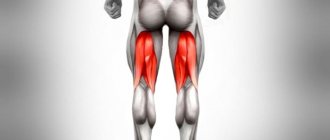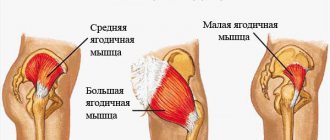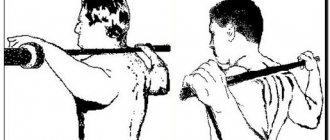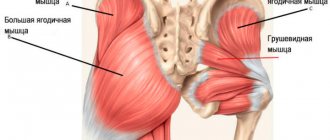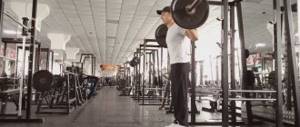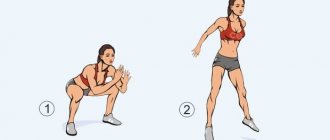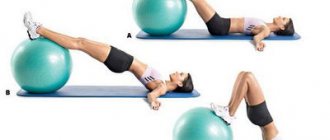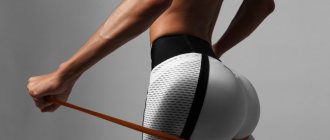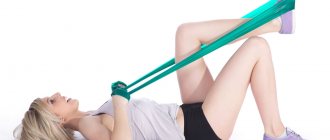Lunges with weights
Many people pay little attention to their legs during training. Accordingly, after some time the lower part of the body begins to lag far behind the top. If you don't put some helpful strategies into practice, your front thigh growth will be extremely slow.
It is necessary, first of all, to pay attention to the technique of performing the exercises. You can shift the emphasis in lower body exercises to the quadriceps. For example, during lunges.
“To shift the emphasis to the quadriceps when performing lunges, you need to take a small step forward so that your knee extends beyond your toe,” says Mike O'Hern, an American bodybuilder and personal trainer. — At the same time, you need to keep your torso straight. By doing this, we reduce the impact of the hamstrings and glutes.”
These nuances are suitable not only for classical lunges, but also for other varieties. For example, for Bulgarian (when one of the legs is located behind on an elevation).
Weighted lunges work all four quadriceps muscles. If a beginner is training, it is better for him to start with dumbbells. If you are an experienced athlete, you can use a barbell.
The algorithm for performing the exercise is as follows:
- Raise the bar onto the supports.
- Assemble the barbell.
- Grasp the bar, squat slightly and take the projectile onto your shoulders.
- Step back 1.5 - 2 meters.
- Inhale, step forward with one leg and lower into a lunge.
- Exhale and return to a vertical position.
- Repeat the same with the other leg.
Anatomy of the quadriceps
The muscle tissue of the thigh can be divided as follows:
- anterior zone – quadriceps;
- back of the thigh - biceps;
- internal – adductor muscles.
During training, special attention should be paid to the quadriceps. It is also called the quadriceps muscle. It consists of 4 muscle bundles:
- Lateral. The largest beam that forms the side of the thigh. Responsible for knee extension.
- Medial. Responsible for knee extension. Forms the frontal surface of the thigh.
- Intermediate. It is located where a free area is formed between the 2 previous beams. Begins to work when bending the knees, squats, running, jumping.
- Straight. The longest beam. It gives the surface of the thigh a rounded shape. This is the only area that does not connect directly to the femur. Responsible for bending and unbending.
The quadriceps, or quadriceps muscle, is one of the largest muscles in the human body.
The front of the thigh provides musculoskeletal stability when a person is in an upright position. Helps the movement of the lower leg when bending and unbending the knees, tilting the pelvis and bringing the legs towards the stomach.
Squats
When performing this exercise, the main load is on the medial and lateral heads, however, the quadriceps muscles are also fully involved.
The order of the exercise is as follows:
- Place the barbell on the rack frame raised to chest level.
- Grab the bar as tightly as possible, and press your upper back against the barbell as you lift.
- Take the weight off the rack and take a couple of steps back.
- As you inhale, squat until your thighs are parallel to the floor.
- As you exhale, rise with a powerful effort.
When performing this exercise, it is important to ensure that your knees do not converge inward.
Sometimes people, when doing squats, do it incorrectly and do not squat all the way. There should be a full range of motion in squats and leg presses.
If you don't squat to at least parallel, studies have shown that quadriceps activation will decrease by more than 50%.
“You also need to develop ankle mobility,” says Mike O'Hern. “Without this, you won’t be able to fully squat or do leg presses without lifting your heels off the floor.”
Features of working with quadriceps
Exercises for the front of the thigh should be done no more than 2-3 times a week. This is due to the fact that the quadriceps is a large muscle that needs a long recovery after training.
For exercises on the outer thigh to be effective, you must adhere to the following rules:
- Add variety to your workouts. Muscles have the ability to adapt to specific exercises, after which they cease to produce the desired result. To prevent this from happening, it is recommended to change your training program every 10-12 weeks. Include non-standard loads.
- Increase the number of repetitions periodically. For example, there were ten approaches. For 2-3 workouts it is recommended to increase them to 20-30 times. This will allow you to load your upper legs a little differently.
- Perform squats “within” the amplitude. This means you don't need to go lower than your thighs are parallel to the floor. At the top point, you should not fully extend your knees. This allows you to create a strong and long-lasting load on the upper thigh area.
- Try training with supersets. For example, do 12 squats with a barbell. Without rest, go to the leg biceps machine. Then perform 12 calf curls.
- Apply a regressive technique. For example, do a set of 5-6 approaches with maximum weight. Then increase the approaches, but at the same time reduce the load on the projectile.
- Remember about pumping. At the end of the strength training on the outer thigh in the gym, do 1-2 exercises with light weight, but the maximum number of repetitions.
The bulk of the workout should consist of basic (multi-joint) quadriceps exercises. They are designed for both mass and strength because they place a complex load on the body and legs. Before heavy exercise, you can do a warm-up consisting of isolated movements such as when training the hamstrings.
Basic exercises are necessary not only for building muscle mass in the legs. They are also useful for women who want to improve their shape and make their figure slim.
The quadriceps muscle is responsible for maintaining the body in a stable upright position, flexes the leg at the hip joint and is involved in bending the knee.
Leg press in the simulator
You can shift the load in other exercises, in particular the leg press. It is extremely important to pay attention to the placement of your feet. Placing your feet on the bottom of the platform will activate your quadriceps.
The order of the exercise is as follows:
- Take a seat in the machine, pressing your lower back tightly against the back.
- Place your feet on the platform.
- Remove the platform from the supports.
- As you inhale, bend your knees and lower the weight.
- As you exhale, press the carriage up.
“Every set I change my position, either inward or outward,” says Mike O'Hern. “I start the set with my toes turned out and then turn them inward at the end of the set. Change your position. You can move your legs. If you want to grow muscles, you must work from different angles, change the position of your feet, breathe correctly. The deeper your breathing, the more muscles are activated. We keep the load in the muscles. We press with the quadriceps."
The more time under tension, the better you will work your muscles, Mike emphasizes. This is a great workout for anyone who can't squat due to lower back problems.
How to pump up the quadriceps muscle after injury
It all depends on the extent of the damage, so the recovery period and training program will be different for everyone.
In any case, it will no longer be possible to continue in the same mode as before the injury; it is necessary to gradually strengthen the damaged muscle.
After consulting with a doctor, we begin training. Everything is simple here, we work on machines with such a weight that the muscle gradually stretches and recovers, and we also use classic squats with our own weight and lunges.
Don't forget that with massage, rehabilitation will go much faster!
Leg extension
This exercise is performed in a seated machine. The order of performing the exercises is as follows:
- Sit in the machine, pressing your lower back tightly against the seat.
- Adjust the height of the foot bolsters.
- Press your shins against the bolsters.
- Grasp the handles located on the sides of the seat.
- As you inhale, lift the emphasis up.
- As you exhale, lower down.
When performing this exercise, you should move smoothly, without jerking.
Barbell clean
This exercise uses not only the quadriceps, but also the buttocks, deltoids, and extensor muscles.
The algorithm for performing the exercise is as follows:
- Place your feet shoulder-width apart.
- Keeping your hips straight, push your back back.
- Grab the bar with both hands. Hands should be shoulder-width apart.
- Raise the barbell with your weight in your heels.
- Straighten your legs sharply when the bar reaches knee level.
- When the bar is at shoulder level, bring your elbows under it so that it rests on your chest.
- Pause by lowering the barbell to the floor.
“The basic rules for this exercise are the following,” says Mike. - First of all, the legs should be located at a short distance. Approximately shoulder width apart. Toes should be slightly turned out to the sides. The back must be controlled throughout the entire exercise. Strong tilting of the body forward and pulling the torso back are also harmful. If you are not sure that you can handle the load, use a belt. And watch your breathing! You cannot hold your breath. Each squat should be accompanied by inhalation and exhalation.”
An effective workout for the quadriceps femoris muscle
The quadriceps muscle is the largest and strongest muscle in the legs. For men, it is especially important to train the thigh muscles rather than the gluteal muscles. The trainer will tell you what exercise machines and devices to use for this. He will determine the optimal load for you and monitor the correctness of the exercises.
The largest muscle in the legs is the quadriceps femoris (quadriceps), which consists of four bundles. Often it is she who takes the main load during various exercises. The level of physical fitness of the whole organism, its endurance and strength depend on the degree of training of these muscles.
The quadriceps is the quadriceps femoris muscle.
The quadriceps femoris muscle performs important functions in stabilizing the body during standing, walking, running and jumping. It is involved in flexion and extension of the legs, reducing the risk of injuries to the knee and hip joints.
Important: To quickly and evenly pump up your quadriceps in the gym, it is better to use the help of an experienced trainer. He will suggest a set of exercises for an effective workout and explain how to perform them correctly.
Barbell bouncing row
When performing this exercise, the quadriceps, deltoids, buttocks, abdominal muscles, and trapezius are involved.
The exercise is performed as follows:
- You need to grab the barbell with an overhand grip. The hands are positioned shoulder width apart.
- Next, you should lower yourself into a half-squat, lowering the bar to your feet just above your knees.
- Straighten up sharply and throw the barbell up using the inertia of your lower body.
- Raise your shoulders and complete the movement.
- Return the bar to its original position.
“Don't swing the barbell,” Mike advises. — The bar should be as close to the body as possible throughout the entire exercise. This exercise should be performed primarily using the pelvic muscles. It is better not to use the muscles of the upper body. Movements must be fast and energetic."
Sport and health
Squats are one of the main basic exercises not only for developing leg muscles, but also for strengthening many muscle groups of the torso. And even more than that, squats can generally be called a universal complex movement that develops almost the entire body. The uniqueness of the exercise is that its implementation causes a powerful production of hormones that stimulate the growth of all muscles. In addition, squats develop endurance, strengthen the cardiovascular system and all kinds of stabilizing muscles of the body, which means the movement is ideal not only for bodybuilding or fitness, but also for other sports that require a stable body position, endurance and muscles as strong as steel. There are two main types of squats: with a barbell on your shoulders and with your own weight. With a barbell on your shoulders is the most hardcore option, where you can use fairly large weights. It is this type of squat that causes the best production of hormones and perfectly develops the legs and gluteal muscles. The main question here is the technique of execution: how to squat, to the parallel of the thigh with the floor or below? Read more about this. Squats with your own weight are more suitable for fitness training of a health nature; they have a general tonic effect, strengthening leg muscles and endurance. Read more about this. However, in the arsenal of such a wonderful exercise there are other options that shift the load more precisely to the quadriceps and place emphasis on the development of stabilizing muscles. These types of movements specifically work the quadriceps, which makes them stronger and visually powerful, and also rapidly develops the ability to maintain balance in various extreme conditions. Three alternative types of squats:
Front squats (with a barbell on the chest). This classic option is performed quite rarely today, but this is what athletes did on a regular basis in ancient times, even before the advent of bodybuilding, in order to train leg strength for lifting barbells. The fact is that this specific position of the bar makes the movement very similar to performing a jerk. Nowadays, speaking purely about bodybuilding, front squats are used mainly by professional bodybuilders who know all the intricacies of effective muscle development. This type of squat significantly shifts the load to the quadriceps, causing them to be worked very powerfully, which improves their strength and detail (relief appearance). The abdominal muscles are also a great workout. Front squats can be performed both up to the parallel of the thigh with the floor, and below, and doing a deep squat here is much safer than in the classic version with a barbell on the shoulders, since the body does not fall forward, remaining in a straight position all the time. In the standard version (with a barbell on the shoulders), the body can fall forward, especially with a full squat below parallel, due to which the knees are heavily overloaded and there is a risk of injury. The front squat technique is quite complex. Before performing them, a thorough warm-up of the legs and back is necessary. In addition, first you need to do several training approaches with your own weight, imagining that you
hold the bar in front of you. This will help you understand the technical nuances based on your body type, as well as get used to the unusual squatting style. The barbell can be held either with an overhand grip, with your hands shoulder-width apart, or with your arms crossed in front of you. In both cases, the hands only hold the bar, while it rests completely on the upper chest and deltoids. There is a variation of front squats in the Smith machine, but this option makes it easier for the stabilizer muscles to work, because the bar here is not balanced, but is strictly fixed and you only have to lift with the strength of your quadriceps and back. Therefore, it is still more effective to do it with a regular barbell. Only moderate working weight should be used, especially at the initial stage. It can even be an empty bar, because even a small load is extremely effective. In the initial position, the barbell should be installed at such a height of the racks that when removing it you squat a little, this will make it more convenient to return it to the racks at the end of the set, and even lift it at the beginning. Squat - inhale, rise - exhale. The back is completely straight. Number of repetitions: 10-12, working sets - 3-4. On a specific leg training day, you should not perform several types of squats at once; it is better to do just one, because each of them affects the entire body as a whole and requires extreme concentration. After such a movement, all that remains is to do additional leg presses, as well as leg extensions and flexions in the simulator.
Zercher squats . This unusual method of strength exercise was invented by Canadian athlete Ed Zercher in the 30s of the last century. A unique feature of the movement is that the load here goes directly to the quadriceps, and if in other types of squats a significant share of the work is performed by the back muscles, here almost the entire load goes to the legs, especially the quadriceps. Plus, the biceps and shoulders are actively involved in the work, because you have to hold the barbell with your hands. The body is stabilized by the lower back and abs, which also receive high-quality, strengthening load. It is more convenient to perform this movement in a power rack, so you can lift more weight when the barbell initially lies on racks installed below, otherwise you will have to lift the barbell from the floor, and this makes the process much more difficult due to the increased amplitude of the tilt and the load on the lower back in initial phase, which is why the weight will have to be reduced. It is important to do Zercher squats at a moderate pace without jerking to protect yourself from the risk of injury to your joints and lower back. Squat - inhale, rise - exhale. Try to concentrate as much as possible on the work of your quadriceps. 8-10 reps for main 3-4 sets.
Bulgarian lunges (squats). Of all types of squats, Bulgarian lunges most effectively eliminate muscle imbalances, that is, they make paired leg muscles equal in strength relative to each other, making classic squats much more effective and stable. In addition, as in the previous two options, small stabilizer muscles, as well as the so-called core, which includes a number of muscle groups responsible for maintaining body position when playing sports and in various everyday activities, are excellently developed here. The main advantage of Bulgarian lunges, along with eliminating muscle imbalances, is their
incredibly powerful effect on the quadriceps and gluteal muscles. The quadriceps get the most effective workout they can get here. Naturally, the results will not keep you waiting. With regular performance of this movement, the leg muscles will certainly become much stronger and acquire a sculpted appearance. Before starting sets, it is important to thoroughly stretch the muscles of your legs and knees so that unilateral squats are completely safe. When doing Bulgarian lunges, you need to keep your back straight, slightly arched at the lower back and look in front of you or slightly up. You can use both a barbell and dumbbells as additional weights. Squat - inhale, rise - exhale. Working weight is moderate. 12-15 reps in main 3-4 sets.
In contact with
LiveJournal
